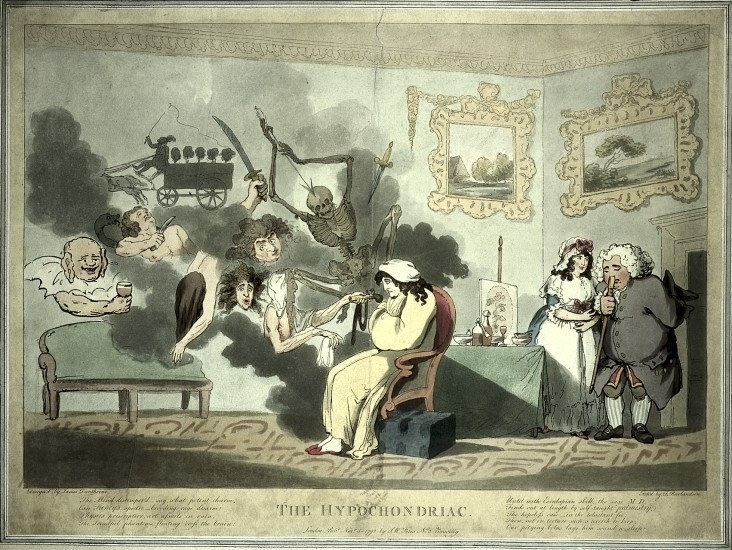
Health anxiety: a history of its treatment
Unsurprisingly, physical health is of the utmost importance to everyone. Some people even become anxious about the processes that take place inside their body to the degree that their anxiety interferes with their daily functioning. Historically, this persistent health anxiety has been referred to as hypochondriasis.
Health anxiety has long been considered difficult to treat because patients typically stick to a medical solution for their concerns, rather than to a psychological solution. Nevertheless, in the past few decades new theoretical insights have contributed to the emergence of specific and effective treatments. A quantitative meta-analysis, in which results from multiple past studies were combined, recently showed that cognitive-behavioural therapy is effective in reducing health anxiety (Olatunji et al., 2014). However, the problem with cognitive-behavioural therapy is that it has evolved into a kind of umbrella concept; it includes a wide variety of treatment techniques and theoretical backgrounds. In other words, while a meta-analysis may be informative to some degree, it does not provide much insight into the question what these treatment actually consist of, and how their content might have changed over time. In addition, meta-analyses only include relatively large-scale studies (cf. Thomson & Page, 2007), thereby neglecting the contribution of case studies and case series to the field.
“It is interesting to learn about the history of treatment studies”
As a complement to the recent meta-analysis on the treatment of health anxiety, I recently generated an overview of the treatment literature from 1970 until 2014. This systematic approach yielded 40 English-language papers (Bouman, 2014a). Rather than calculating the quantitative effects of these studies, I provided a description of the content of each treatment, the setting in which it was given, and the instruments that were used. This qualitative approach yielded a different perspective on the treatment of health anxiety.
In particular it was very interesting to discern the scientific and clinical changes in the approaches to treatment. The history starts with simple case descriptions in the 1970s and 1980s. In the 1990s there was a rise in large scale studies in which an active treatment was compared to a wait list condition. However, state of-the-art randomized controlled trials have been carried out only since the beginning of the 21st century. Thus, the quality of the studies has increased over time, both in terms of sample size and in terms of methodology.
A particularly interesting outcome of my qualitative approach was that I learnt about the changing content of the treatment of health anxiety. In the 1970s, when most clinical psychologists were behaviourists, treatments were primarily focused on exposing patients with health anxiety to the objects and situations that provoked their anxiety, a technique known as systematic desensitization. In the 1990s, the emphasis shifted to a more cognitive approach, which involved scrutinizing the validity of patients’ beliefs about their bodily symptoms. In recent years mindfulness interventions, which aim to teach patients to accepting their thoughts and feelings in a gentle way, have been incorporated as well.
“Every researcher wants to leave his mark in the treatment literature”
Diversity in the studies on the treatment of health anxiety was also observed in the settings in which the various treatment approaches were investigated, ranging from primary mental health care, to outpatient facilities, to specialized hospital settings. Moreover, the ways in which the treatments have been delivered varied from individual approaches, to group approaches, to bibliotherapy (i.e., reading about health anxiety and how to deal with it), to internet-based treatments (with its emphasis on providing web-based information, exercises, and interaction with a therapist).
The downside of this wide variety in where and how the treatments have been applied is that there are generally only one or two studies that examined a particular combination of treatment content and format. Convincing replications of study findings are missing. When reflecting on the treatment developments that have taken place thus far, I wondered whether all researchers seemed to want to add something new and different to the literature. Clearly this has led to a proliferation of the content and format of treatments, rather than to a verification of previous studies.
“Diagnostic criteria for health anxiety are changing in a less useful direction”
Another obstacle to replication is the recent change in the diagnostic criteria related to health anxiety. The fifth version of the Diagnostic and Statistical Manual of Mental Disorders (APA, 2013) has abolished the diagnosis of hypochondriasis. Instead there are two new categories for health anxiety, namely ‘somatic symptom disorder’ and ‘illness anxiety disorder’. The main criterion for receiving one diagnosis instead of the other is the number of reported somatic symptoms. Unfortunately, these new diagnostic concepts lack a historical background as well as a research tradition, thereby precluding comparison with earlier findings (Bouman, 2014b).
My overview provides one example of how treatment for mental disorders is subject to fashion trends and the craving for innovation. On the one hand our desire to do something new helps us explore the boundaries of what we know. On the other hand it precludes the replication of findings. We should not forget that science is not only about innovation, but also about obtaining solid knowledge.
References
American Psychiatric Association. (2013). Diagnostic and statistical manual of mental disorders, (DSM-5). Arlington VA, American Psychiatric Publishers.
Bouman, T. K. (2014a). Psychological treatments for hypochondriasis: A narrative review. Current Psychiatry Reviews, 10, 58-69.
Bouman, T. K. (2014b). Somatic symptom and related disorders. In P.H. Blaney, R. Krueger, & T. Millon (Eds). Oxford textbook of psychopathology. New York: Oxford University Press. (pp. 540-565)
Olatunji, B. O., Kauffman, B. Y., Meltzer, S., Davis, M. L., Smits, J. A., & Powers, M. B. (2014). Cognitive-behavioral therapy for hypochondriasis/health anxiety: A meta-analysis of treatment outcome and moderators. Behaviour research and therapy, 58, 65-74.
Thomson, A., & Page, L. (2007). Psychotherapies for hypochondriasis. The Cochrane Library.
Note: Image by Penny Bentley, licenced by CC BY 2.0.



